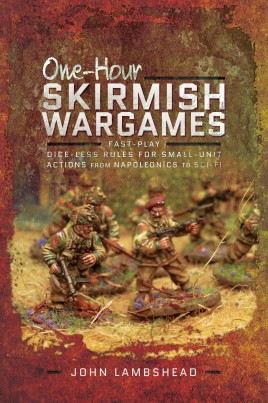
Fast-Play Diceless Rules for Small-Unit Action From Napoleonics to Sci-Fi
Total Votes: 12
Description
The book begins with a one-page Foreward, which acknowledges the success of the previous ruleset in the series (One-Hour Wargames by Neil Thomas), and sets the design goals: simple without being simplistic, and realistic without being complicated.
Next comes a five-page General Introduction, which provide a combination of designer's notes and observations about the shortcomings of previous rulesets. He defines a 'skirmish wargame' as one in which one model represents one soldier, and each soldier acts individually. He feels a skirmish wargame should play in close to 'real time', without a lot of recordkeeping, calculations or tables. He has chosen to use cards rather than dice to keep the game fast-moving, and to allow a wide spread of outcomes (which he feels is realistic for a skirmish-level game). He also feels that players prefer a 'heroic' style of game.
The rest of the rulebook is split into three sections: The Early Days of Firearms, The Twentieth Century, and Extending the Game.
The Core Rules
The initial twelve-page chapter in this section provides the Core Rules of the game. The game is played in alternating Player Phases; a drawn card determines how many Action Points a player receives in that turn. Action Points are spent to activate figures to move, fire, or conduct special actions. A figure can move up to three times per phase, at increasing cost in Action Points; one a player fires, its movement is over. The phase ends when the player runs out of points, opts to pass, or draws a Joker.
When combat occurs, both players draw cards and the highest wins; the number of cards drawn depends on the type of combat (ranged or close), the type of figure (soldier or leader), and the situation of the defender (such as behind a wall). A figure injured in combat becomes Downed and can no longer move or fire.
When both players have finished their phases, morale is checked; a bad result may end the game. Next, each Downed figure is tested: they might return to combat, remain Downed, or become Casualties. Casualties are removed from play, and count against morale tests.
Weapons are rated in terms of range and number of shots. Individuals may have special abilities, such as Dead Shot or Fast.
Leaders have various ratings, which allow them to draw more cards in combat and to influence morale checks. Leaders are highly effective in combat, but risking a leader and losing him will affect future morale checks.
Units also have a Motivation rating, which influences morale checks.
Period-Specific Rules & Scenarios
The following chapters each provide special rules for particular historical periods, followed by a sample scenario:
- Age of the Musket
- Provides a page of introduction and two pages of special rules for Napoleonic combat (covering muzzle-loading rifles, cavalry, and cannon). These rules are specifically for the Napoleonic period, but can be used from the Renaissance up to the mid-19th Century. The scenario, Capture the Cannon, challenges the French (6 cavalry, 10 infantry) to drive off the British (7 infantry, 4 riflemen) in order to capture a cannon.
- The Rifle Era
- Introduction to late 19th Century warfare, with special rules for natives and Gatling-type weapons. The scenario, Zulu, challenges the Zulus (16 figures) to assault a British redoubt (8 riflemen).
- Wars Within Peace
- Provides an introduction to the machinegun era, with seven pages of special rules covering grenades, vehicle combat, and flamethrowers. Can be used for mobile warfare from WWI through the interwar years. The scenario, Freikorps - 'Drang nach Osten!', involves Freikorps (15 figures) searching a Bolshevik village (12 figures, Maxim gun, armored car) for a hidden objective.
- World War II
- Introduction and a half-page of special rules (new weapons). The scenario, Plan Tortue, challenges the French Resistance (15 figures) to prevent a German convoy (12 figures, 3 vehicles) from traveling along a forested road.
- The Cold War
- Introduction and page of special rules covering modern tank and anti-tank combat. The scenario, Grave of Empires, involves combat when Soviets (8 figures, 1 automatic grenade launcher with crew) ambush a Mujahideen vehicle (1 car with 3 passengers, 8 motorcyclists, 7 reinforcements).
- Pulp Action
- Provides three pages of general guidelines for Astounding Heroes-style combat involving heroic crimefighters, magic, or superweapons. The scenario, Retro Rockets, involves rescuing a professor from the middle of a dinosaur-infested marsh. The forces are the RAF (12 figures) versus the Troon of Venus (11 figures). Special rules cover sci-fi weapons, flying vehicles, and dinosaurs.
Additional Rules
In Campaign Rules (11 pages), the designer introduces ladder and map campaigns, and provides a sample of both a map and a narrative campaign set on the Russian Front in WWII. Complex campaigns are discussed, as well as a basic experience point system.
Points System (4 pages) introduces a system for generating forces using points, including a list of point costs and sample point values for particular fighters and equipment.
The final chapter, Additional Rules (5 pages), discusses ideas or rules for decreased visibility, random events such as artillery shells, and deteriorating situations (such as toxic smoke).









